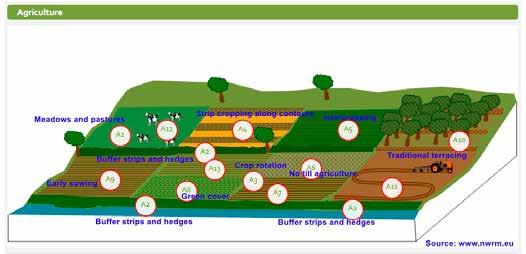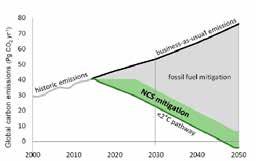Scientific Papers. Series E. Land Reclamation, Earth Observation & Surveying, Environmental Engineering. Vol. XI, 2022
Print ISSN 2285-6064, CD-ROM ISSN 2285-6072, Online ISSN 2393-5138, ISSN-L 2285-6064
OPPORTUNITIES TO APPLY NATURE-BASED SOLUTIONS IN ROMANIA IN THE CONTEXT OF EUROPEAN COMMON AGRICULTURE POLICY
Adriana-Magdalena PIENARU1, Dan RĂDULESCU2
1University of Agronomic Sciences and Veterinary Medicine of Bucharest, 59 Marasti Blvd, District 1, Bucharest, Romania
2Independent Consultant, Bucharest, Romania
Corresponding author email: apienaru@gmail.com
Abstract
The agriculture is facing different pressures linked to diffuse pollution from nutrients and chemicals, water abstraction and hydromorphological changes. According to information reported under the Water Framework Directive, around one third of surface water bodies fail to achieve good status because of one or several of these pressures. Using sustainable management practices based on agroecological principles, organic farming, and nature-based solutions, with multiple sustainability benefits, can contribute to reducing the magnitudes of pressures on water, enhancing the long-term resilience of agriculture to climate changes and benefit biodiversity. Investing in treatment plants, pipes, and conveyance schemes, is often the most trusted solution, but conventional engineered methods represent end-of-pipe solutions that do not address pollution at the source The paper is presenting opportunities for green infrastructure and nature-based solutions application in Romania to aid in addressing some of the situations mentioned above.
Key words: agriculture, green infrastructure, nature-based solutions, diffuse pollution, Romania.
INTRODUCTION
According to the data included in the National Management Plan - Danube International River Basin Segment in Romania - Update 2021, agricultural activities are a major source of diffuse pollution, mainly due to nitrogen and phosphorus releases (MMAP-ANAR, 2021) According to the same document, agricultural activities contribute with approximatively 22.5% of the loads from nitrogen and 55 2% of the loads from phosphorus to the receiving waters Although a significant reduction of releases from these compounds have been noticed since the last National Management Plan 2015, agricultural sector remains a significant source of diffuse pollution that puts pressure on achieving the good water status outlined in the European Union’s Water Framework Directive. It is undeniable that water resources worldwide are under tremendous stress, especially due to the population migration from rural to urban areas and the spectre of climate changes.
In 2018, based on United Nations data, approximately 55% of the world's population lived in urban areas, and by 2050 this
percentage is expected to reach 68% (“68% of the world population”, 2018).
While this migration from rural to urban areas poses significant pressures on water resources in and around urban areas, at the same time, it increases the demands on agricultural yields and therefore the needs for water resources and production lands while there is a substantial conversion of land use. In addition, structural works constructed to protect agricultural production lands from flooding add to the hydromorphological changes pressures on the watercourses by limiting their continuity and disturbing the riverine and fluvial ecosystems. Climate change also intensifies the desertification phenomenon, disturbs the weather patterns, and increases the frequency of extreme rain events, in addition to the other challenges. In this context, the paper describes an analysis of the opportunities available to apply naturebased solutions in the agricultural context where conventional structural engineering methods may not be as suitable under the new circumstances In addition, at the international level there is a serious change of paradigm, from intensive agriculture to more nature friendly, ecological methods.
Scientific Papers. Series E. Land Reclamation, Earth Observation & Surveying, Environmental Engineering. Vol. XI, 2022
Print ISSN 2285-6064, CD-ROM ISSN 2285-6072, Online ISSN 2393-5138, ISSN-L 2285-6064
soils lay at the foundations of agricultural development, healthy and nutritious food production, and essential ecosystem services, which are crucial to our basic survival as well as our planet’s sustainable future (FAO - Soils Portal, 2022). The soil’s function of supporting food and agriculture worldwide is fundamental for the preservation and advancement of human life on this planet. Soil is increasingly recognized as playing a fundamental role in the quality and availability of our water supply. The soil, coupled with the landscape and its vegetation is responsible for the distribution of all rainwater falling upon it and thus plays a key role with respect to the water cycle and supply as now recognised by hydrologists. Related to how water moves through the soil and the absorption properties of soils is the soil's ability to perform an important function in pollution control (pesticides, nitrates, etc).
Furthermore, the EU Common Agricultural Policy (CAP) reform proposed by the European Commission in 2018 has common goals with the Green Deal in the environmental area by promoting climate change action, environmental care and landscape and biodiversity preservation (“Key policy objectives of the new CAP”, 2022). The new CAP has introduced an enhanced conditionality for environmental protection. In support of the new CAP and other EU initiatives, the EU Soil Strategy sets the baseline for more ambitious and sustainable agricultural commitments through environmentand climate-friendly farming practices under eco-schemes and rural development interventions. Member States should better integrate soil and land use management in their river basin and flood risk management plans where possible by deploying nature-based solutions such as protective natural features, landscape features, river restoration, floodplains, etc. One of the main actions contained in the EU Soil Strategy for 2030 is making sustainable soil management the new normal, by proposing a scheme for landowners to get their soils tested for free, promoting sustainable soil management through the CAP and sharing best practices (European Commission, 2021).
Emphasis is put on activities that are sustained by good environmental approaches that can achieve a sustainable system of agriculture. As an example, the CAP preserves both the
quantity and quality of water used in agriculture by establishing buffer strips along watercourses, and by supporting more efficient irrigation systems, among other measures. In addition, rural development policy encourages actions that conserve and enhance biodiversity, such as providing funds for the establishment and maintenance of landscape features and "wildlife corridors”, and supporting high nature value farming systems and nature management plans that nurture wildlife-friendly areas (“An environmental sustainable CAP”, 2022).
Moreover, a suite of natural water retention measures (NWRMs), that are identified as multifunctional measures that aim to protect and manage water resources using natural means and processes, can be implemented in areas where agricultural activities occur. Typically, NWRMs can deliver multiple benefits, including reduced greenhouse gas emissions, habitat improvement, flood risk reduction, water quality improvement, groundwater recharge and drought management (EEA, 2020). Several NWRMs suitable for agriculture are outlined in Figure 2. In a key document on the topic, three issues are emphasised: 1) Nature-based solutions (NbS) are cost-effective interventions that can enhance resilience in agriculture and food production, while mitigating climate change and enhancing the environment; 2) Agricultural producers have a critical role in implementing NbS in their operations and can help to shape wider landscape scale approaches to naturebased solutions; 3) Policy makers can enable the implementation of nature-based approaches through a variety of means including by law and regulation, economic incentives, capacity building, and communications (Iseman & Miralles-Wilhelm, 2021).
It is estimated that nature-based solutions implemented across all ecosystems can deliver emission reductions under the scenarios outlined by the Intergovernmental Panel on Climate Change (IPCC): “approximately 62% of this contribution is estimated to come from nature-based solutions related to forests, about 24% from solutions in grasslands and croplands, and 10% from additional solutions in peatlands.
The remaining 4% will come from solutions implemented in coastal and marine ecosystems” (UNEP, 2021).
Scientific Papers. Series E. Land Reclamation, Earth Observation & Surveying, Environmental Engineering. Vol. XI, 2022
Print ISSN 2285-6064, CD-ROM ISSN 2285-6072, Online ISSN 2393-5138, ISSN-L 2285-6064

Based on another study, natural climate solutions (NCS), another term for nature-based solutions, can provide 37% of cost-effective CO2 mitigation needed through 2030 for a > 66% chance of holding warming to below 2°C, as shown in Figure 3 (Griscom, 2017).

The research evaluated the importance of 20 conservation restoration, and improved land management actions that increase carbon storage and/or avoid greenhouse gas emissions across global forests, wetlands, grasslands, and agricultural lands. These NCS were chosen because they offer multiple benefits through water filtration, flood buffering, soil health, biodiversity habitat, and enhanced climate resilience
The United Nations Development Programme, through its Climate and Forests Programme,
also emphasizes the importance of taking into consideration the integration of nature-based solutions in the Agriculture, Forestry and Other Land-Use sector (AFOLU). It is suggested that NbS could provide a cost-effective solution for climate mitigation, adaptation and slowing of biodiversity loss (UNDP, 2021).
On the other hand, the implementation of nature-based solutions can be a viable approach to coping with environmental issues related to diffuse water pollution from agriculture. NbS use natural processes to remove pollutants from agricultural wastewater and they can also enable the recovery of otherwise lost resource, such as, nutrients (Mancuso G. et al., 2021). The benefits of NbS are shown in Figure 4.
An important case for supporting the new paradigm in Romania is represented by the approval of the first standard for ecological agriculture “SR 13595:2022 - Organic farming. Requirements and recommendations for environmentally sustainable products”. This original standard highlight that the purpose of organic farming is to produce cleaner food, to put on the market fresh and authentic agri-food products that respect natural and environmental factors, in full correlation with the conservation and development of a sustainable environment. The standard can be used as a reference for certification and is applicable to ecologically certified organizations that want to apply the principles of agroecology. The standard can
Scientific Papers. Series E. Land Reclamation, Earth Observation & Surveying, Environmental Engineering. Vol. XI, 2022
Print ISSN 2285-6064, CD-ROM ISSN 2285-6072, Online ISSN 2393-5138, ISSN-L 2285-6064
European Commission, EU Soil Strategy for 2030 –COM (2021) 699 final European Commission, Green Infrastructure (GI). Enhancing Europe’s Natural Capital (2013). COM (2013) 249 final
European Court of Auditors (2018). Special Report No 33, Combating desertification in the EU: a growing threat in need of more action
European Environment Agency (2020). Water and agriculture: towards sustainable solutions, EEA Report No 17/2020. ISSN 1977-8449
European Environment Agency (2021). Nature-based solutions in Europe: Policy, knowledge and practice for climate change adaptation and disaster risk reduction, EEA Report No 01/2021. ISBN 978-929480-362-7
FAO – Soils Portal https://www.fao.org/soils-portal/en/ accessed on February 23, 2022
Griscom, B. W. et al. (2017). Natural Climate Solutions. Proceedings of the National Academies of Sciences of the United States of America, 144(44), 11645-11650. Iseman, T. and Miralles-Wilhelm, F. (2021). Naturebased solutions in agriculture – The case and pathway for adoption. Virginia. FAO and The Nature Conservancy. https://doi.org/10.4060/cb3141en
Mancuso, G. et al. (2021). Diffuse Water Pollution from Agriculture: A Review of Nature-Based Solutions for Nitrogen Removal and Recovery. Water, 13, 1893. https://doi.org/10.3390/w13141893
Ministry of Environment, Water and Forests, National Administration “Romanian Waters” (2021). Updated national management plan for the part of the international river basin of the Danube River that is included in the territory of Romania
National Standardisation Body - ASRO. SR 13595:2022. Organic farming. Requirements and recommendations for environmentally sustainable products
UN DESA - United Nations Department of Economic and Social Affairs accessed on January 20, 2022
United Nations Development Programme (2021). Considerations for integrating Nature-based Solutions into Nationally Determined Contributions: Illustrating the potential through REDD+. New York, USA: UNDP
United Nations Environment Programme and International Union for Conservation of Nature (2021). Nature-based solutions for climate change mitigation. Nairobi and Gland. ISBN: 978-92-8073897-1
